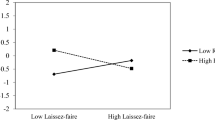Abstract
This paper focuses on the leadership and communication as an information source in decision-making. The paper considers models of communication and debate in a public environment. The paper proposes: (I) a normative model showing how communication can be conducted; and (II) a content analysis of three Obama vs. McCain presidential debates with a multidimensional scaling and a Delphi method application. This paper analyse the association of the messages in debates with debaters and the comparison between their use and the results (communicated through instant polls after each debate). Findings indicate that arguments of leaders in presidential debates can explain the behavior of the followers and could be used for forecast analysis since reveal future political decisions. Causes of the economic crisis and strategies for solution were identified.






Similar content being viewed by others
References
Baxter, L. A. (1988). A dialectical perspective on communication strategies in relationship development. In S. W. Duck, D. F. Hay, S. E. Hobfoll, W. Ickes, & B. Montgomery (Eds.), Handbook of personal relationships (pp. 257–273). Chichester: Wiley.
Bélanger, E., & Soroka, S. (2012). Campaigns and the prediction of election outcomes: Can historical and campaign-period prediction models be combined? Electoral Studies, 31, 702–714.
Benoit, W. L., & Harthcock, A. (1999). Functions of the great debates: Acclaims, attacks, and defense in the 1960 presidential debates. Communication Monographs, 66, 341–357.
Bligh, M. C., & Kohles, J. C. (2009). The enduring allure of charisma: How Barack Obama won the historic 2008 presidential election. The Leadership Quarterly, 20, 483–492.
Callahan, K. (2006) Elements of effective governance: measurement, accountability and participation. CRC Press, 360 p.
Carroll, J.D. and Wish, M. (2002) “Multidimensional Scaling: Models, Methods, and Relations to Delphi”, in The Delphi Method Techniques and Applications. Harold A. Linstone and Murray Turoff (Ed.).
Casasanto, D., & Jasmin, K. (2010). Good and bad in the hands of politicians: Spontaneous gestures during positive and negative speech. PlosOne, 5(7), 1–5.
Cicerón, M.T. (1992) El orador. Traducción tovar & bujaldón. Madrid: Consejo Superior de Investigaciones Científicas C.S.I.C.
Cicerón, M.T. (1996) De oratore. Books I–II/Cicero, with an English translation by E.W. Sutton, completed, with an introduction by H. Rackham, 1st ed, 6th repr. rev. Cambridge (MA), London: Harvard University Press.
Davis, K. M., & Gardner, W. L. (2012). Charisma under crisis revisited: Presidential leadership, perceived leader effectiveness, and contextual influences. The Leadership Quarterly, 23(4), 918–933.
Den Hartog & Verburg (1997) Charisma and rhetoric: Communicative techniques of international business leaders. Leadership Quarterly. Greenwich, Vol. 8, Iss. 4; pg. 355, 37 pgs
Descartes, R. (1649) A discourse of a method for the well guiding of reason, and the discovery of truth in the sciences. Printed by Thomas Newcombe, London.
Donmoyer, R. (1993). Art criticism as a guide to student evaluation. Theory into Practice, 32(4), 252–59.
Easton, G., & Araujo, L. (1997). Management research and literary criticism. British Journal of Management, 8, 99–106.
Ekman, P., & Friesen, W. (1969). The repertoire of nonverbal behavior: Categories, origins, usage and coding. Semiotica, 1, 49–98.
Festinger, L. (1962). A theory of cognitive dissonance. Stanford: Stanford University Press.
Fischer, F (2006) Deliberative policy analysis as practical reason: Integrating empirical and normative arguments. In Handbook of public policy analysis. Frank Fischer, Gerald Miller, Mara S. Sidney (Ed.), CRC Press, 223–236.
Fischer, F., Forester J. (1993) The Argumentative turn in policy analysis and planning. Duke University Press, 327p.
Gallo, C. (2008). How to inspire people like Obama does. March: BusinessWeek. 3.
González, J. F. (1998). El Lenguaje Corporal: Claves de la comunicación no verbal. Madrid: Edimat Libros S.A.
Goodell, J. W., & Vahamaa, S. (2013). US presidential elections and implied volatility: The role of political uncertainty. Journal of Banking and Finance, 37(3), 1108–1117.
Gordon, A., & Miller, J. L. (2004). Values and persuasion during the first Bush–Gore presidential debate. Political Communication, 21(1), 71–92.
Gottweis, H. (2006). Rhetoric in policy making: between logos, ethos, and phatos. In: F. Fischer, G. Miller, M. S. Sidney (Ed.) Handbook of public policy analysis. CRC Press, 223–236.
Gronbeck, B.E. (2004). Rhetoric and politics. In: L.L. Kaid (Ed.) Handbook of political communication research. Routledge 135–154.
Habermas, J. (1998). On the pragmatics of communication. Cambridge: The MIT Press.
Hajer, M.A. (2003). Deliberative policy analysis: Understanding governance in the network society. Cambridge University Press, 307p.
Hart, R. P., & Lind, C. J. (2010). Words and their ways in campaign’08. American Behavioral Scientist, 54(4), 355–381.
Hatry, H.P. (2007). Performance measurement: Getting results. Urban Institute Press, 326 p.
Heider, F. (1946). Attitudes and cognitive organization. Journal of Psychology, 21, 107–12.
Heider, F. (1958). The psychology of interpersonal relations. New York: Wiley.
Holzer, M., Yi, S., Lee, S. (2004). Public productivity handbook. CRC Press, 715 p.
Hovland, C. I., Janis, I. L., & Kelley, H. H. (1953). Communication and persuasion. New Haven, CT: Yale University Press.
Hovland, C. I., Janis, I. L., & Kelley, H. H. (1967). Reinforcement theory. In R. M. Elliot, G. Lindzey, & K. MacCorquodale (Eds.), Theories of attitude change (pp. 12–63). New York: Appleton.
Jorgensen, C., Kock, C., & Rorbech, L. (1998). Rhetoric that shifts votes: An exploratory study of persuasion in issue-oriented public debates. Political Communication, 15, 3(1), 283–299.
Kant, I. (2005a). Critica de la razón pura, traducción Pedro Rivas. Madrid: Taurus Ediciones, S.A. Grupo Santillana.
Kant, I. (2005b). Metafísica de las costumbres, traducción Adela Cortina Orts. Madrid: Tecnos.
Kruskal, J. B. (1964). Multidimensional scaling by optimizing goodness of to a nonmetric hypothesis. Psychometrika, 29, 1–27.
Kruskal, J. B., & Wish, M. (1978). Multidimensional scaling. Beverly Hills: Sage.
Lakatos, I., & Musgrave, A. (1970). Criticism and the growth of knowledge, vol. 4. London: Proceedings of the International Colloquium in the Philosophy of Science, Cambridge University Press.
Lassus, R. (1992). La communication efficace par la PNL (The effective communication for NLP). Alleur: Marabout.
Leong, E., Ewing, M. & Pitt, L. (2004) “Analysing competitors’ online persuasive themes with text mining”. Marketing Intelligence & Planning, Vol. 22 Nº 2 pp.187-200.
Lloyd, J. (2009). Keeping both the baby and the bathwater: scoping a new model of political marketing communication. International Review on Public and Non-Profit Marketing, 6, 119–135.
Marx, K. (1992). El capital: Crítica de la economía política. México: Fondo de cultura económica.
McCloskey, D. N. (1985). The rhetoric of economics. Madison: The University of Wisconsin Press.
McCornack, S.A. (1992). Information manipulation theory. Communication Monographs, 59(1), 1–16.
McDavid, J.C., Hawthorn L.R.L. (2005) Program evaluation & performance measurement: An introduction to practice. SAGE, 477 p.
McGee, B. R. (2001). Assessing argumentation in the 2000 political campaigns. Contemporary Argumentation & Debate, 22, 41–42.
McGuire, W. (1961). Resistance to persuasion conferred by active and passive prior refutation of the same and alternative counterarguments. Journal of Abnormal and Social Psychology, September, 63(2), 326–332.
Mehrabian, A. (1971). Silent messages. Belmont: Wadsworth.
Mey, J. L. (1993). Pragmatics. Oxford: Blackwell.
Morris, E., & Johnson, J. M. (2011). Strategic Maneuvering in the 2008 Presidential Debates. American Behavioral Scientist, 55(3), 284–306.
Norpoth, H., & Perkins, D. F. (2011). War and momentum: The 2008 presidential nominations. PS-Political Science & Politics, 44(3), 536–543.
Olson, J., Ouyang, Y., Poe, J., Trantham, A., & Waterman, R. W. (2012). The Teleprompter Presidency: Comparing Obama’s Campaign and Governing Rhetoric. Social Science Quarterly, 93(5), 1402–1423.
Ortigueira Bouzada, M. & Ortigueira Sánchez, M. (2001) Liderazgo organizacional: instrumentos para dominar y controlar situaciones y problemas difíciles (Organizational leadership: Instruments to dominate and control situations and difficult problems). Seville: Editorial @ 3D.
Ortigueira Sánchez, Luis Camilo (2008). Criticism and Counter-Criticism of Public Management: Strategy Models. In R.A. Oglesby & M.G. Adams (Eds.), Business Research Yearbook, Publication of the International Academy of Business Disciplines, Vol XV number 2, 743–748.
Osgood, C., & Tannenbaum, P. (1955). The principle of congruity in the prediction of attitude change. Psychology Review, 62, 42–55.
Pease, A. (1994). El lenguaje del cuerpo. Barcelona: Ediciones Altaya S.A.
Poister, T.H. (2003). Measuring performance in public and nonprofit organizations. John Wiley and Sons, 289p
Rank, H. (1976). Teaching about public persuasion. In D. Dietrich (Ed.), Teaching and doublespeak. Urbana: National Council of Teachers of English.
Real, J.E. (2001). Escalamiento Multidimensional (Multi-dimensional Scaling). Edit. La Muralla, Edit. Hespérides. Madrid.
Rokeach, M., & Rothman, G. (1965). The principle of belief congruence and the congruity principle as models of cognitive interaction. Psychological Review, 72, 128–142.
Salanti, A. (1989). Distinguishing ‘Internal’ from ‘external’ criticism in economic methodology. History of Political Economy, 21(4), 635–639.
Seyranian, V., & Bligh, M. C. (2008). Presidential charismatic leadership: Exploring the rhetoric of social change. The Leadership Quarterly, 19, 54–76.
Shapiro, I. (1992). Political criticism. Berkeley: University of California Press.
Sheppard, I. (1986). “Silent signals”, Supervisory Management, vol. 31. Iss., 3, 31–33.
Sherif, M., & Hovland, C. I. (1961). Social judgment. New Haven: Yale University Press.
Silverman, B. (1992). Survey of expert critiquing systems: Practical and theoretical frontiers. Communications of the ACM, 35(4), 106–127.
Studer, J. (1999). Guía práctica de oratoria. Madrid: Editorial El Drac, S.L.
Tresch, A. (2009). Politicians in the media: Determinants of legislators’ presence and prominence in Swiss newspapers. The International Journal of Press/Politics, 14(1), 67–90.
Vahidov, R., & Elrod, R. (1999). Incorporating critique and argumentation in DSS. Decision Support Systems, 26, 249–258.
Vahidov, R., & Fazlollahi, B. (2004). Pluralistic multi-agent decision support system: A framework and an empirical test. Information & Management, 41(7), 883–98.
Van Buuren, A. W., Klijn, E.-H., & Edelenbos, J. (2012). Democratic legitimacy of new forms of water management in the Netherlands. International Journal of Water Resources Development, 28(4), 629–645.
Von Wartburg, W. P. (1998). Dealing with public criticism—The lessons of experience. Strategic Communication Management, 2(4), 38–41.
Walliser, B. (1977). Systèmes et modèles. Introduction critique à l’analyse de systèmes (pp. 220–222). Paris: aux Éditions du Seuil.
Warner, B. R., Carlin, D. B., Winfrey, K., Schnoebelen, J., & Trosanovski, M. (2011). Will the “Real” Candidates for President and Vice President Please Stand Up? 2008 Pre- and Post-Debate Viewer Perceptions of Candidate Image. American Behavioral Scientist, 55(3), 232–252.
Wholey, J.S., Hatry, H.P., Newcomer K.E. (2004). Handbook of practical program evaluation. John Wiley and Sons, 720 p.
Wilson-Kratzer, J. M., & Benoit, W. L. (2010). A functional analysis of press releases from Senator Barack Obama and Senator John McCain during the 2008 primary presidential election. Public Relations Review, 36, 178–180.
Author information
Authors and Affiliations
Corresponding author
Rights and permissions
About this article
Cite this article
Ortigueira-Sánchez, L.C. Leadership and the role of communication in public marketing management. Int Rev Public Nonprofit Mark 11, 13–29 (2014). https://doi.org/10.1007/s12208-013-0105-9
Received:
Accepted:
Published:
Issue Date:
DOI: https://doi.org/10.1007/s12208-013-0105-9




